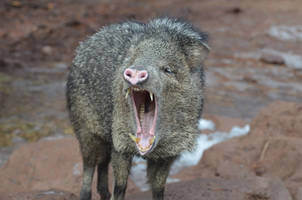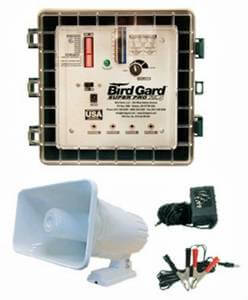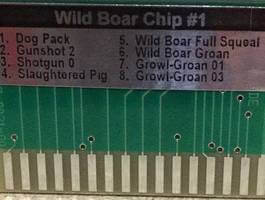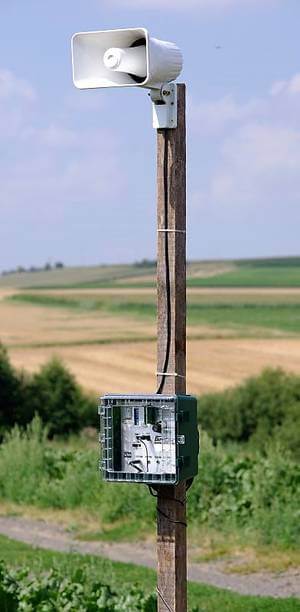The wild boar is included in the list of the top one hundred most harmful invasive species in the world. Wild boars devastate crops, especially olive groves, vineyards, and cornfields, causing significant losses. Beyond homemade solutions to scare away wild boars—which are of little effectiveness—farmers need professional solutions to effectively and permanently deter wild boars.
This article presents professional solutions to deter wild boars. But before installing a solution to deter wild boars, it is advisable to have a good understanding of the characteristics of this animal, its habitat, reproduction and breeding periods, and the main problems caused by wild boars.
Main characteristics of Wild Boars to understand how to deter them
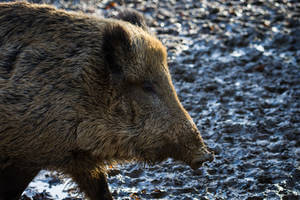
The wild boar has a large head and very small eyes. In fact, wild boars have poor vision and see in black and white. Therefore, they compensate for their poor eyesight with highly acute hearing and sense of smell.
The wild boar has a highly developed sense of smell, which it uses to locate its food even from more than a hundred meters away: fruits, roots, tubers, barks, cereals, insects, worms, and even small reptiles. The hearing of the wild boar is also highly developed. Wild boars can perceive sounds that are imperceptible to humans.
Wild Boar Habitat. Where Do We Find the Most Wild Boars?
Wild boars are very sociable animals. Except for old males, which live alone, wild boars usually travel in a family group of about two to seven individuals. This group consists of a male, a female, and their offspring. However, occasionally, groups of more than twenty individuals can be observed.
The wild boar adapts to both forested areas and agricultural zones. It prefers places with tall vegetation where it can seek protection and areas abundant in water. Wild boars enjoy wallowing in mud. The wild boar is present throughout the Iberian Peninsula, with higher concentrations in the central region, northern Andalusia, and Catalonia.
The wild boar is nocturnal. During the day, it is a sedentary animal that usually rests in its burrow dug in the ground. Typically, wild boar burrows are found in hidden places with dense vegetation. During the night, wild boars become active and can cover distances of about 2 to 12 kilometers.
Wild Boar Reproduction. Increase in Wild Boar Population
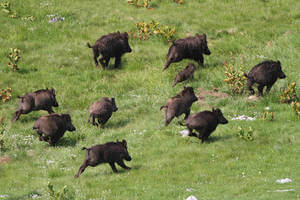
The mating season for wild boars usually occurs from November to December-January. The gestation period for wild boars is 4 months. The first offspring are usually born between February and April. Typically, wild boars have one litter per year, but they can have two litters, with three to five offspring in each litter.
The young of the wild boar, or piglets, are born with stripes along their bodies, which is why they are also known as striped piglets. These stripes disappear between 6 and 12 months of age, and their fur changes to a reddish color at one year old. That’s why young males are called “red males.” The fur of the wild boar ultimately changes to a brown or black color in adult individuals.
In Europe, the wild boar species is not endangered or threatened. The increase in the wild boar population leads to them approaching crops and even houses, devastating everything in their path.
Issues Caused by Wild Boars
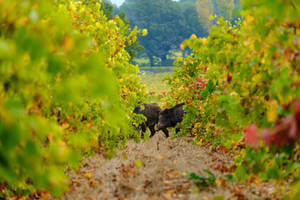
The wild boar is included in the list of the 100 most damaging invasive exotic species in the world. Among the most frequent problems caused by wild boars are:
- Wild boars enter and eat crops, causing significant losses. They mainly attack olive trees, vines, cornfields, orchards, and other crops surrounded by forests. The boars have their burrows and hideouts in the forest, which is why farmers affected by this problem need solutions to prevent wild boars from eating their crops.
- The most significant wild boar attacks in cornfields usually occur between March/April and July.
- During the corn planting season – usually between April and May – wild boars can unearth and consume the seeds. This happens more frequently after rainfall when the field is moist. The moisture in the soil makes it easier for the boar to dig and eat the corn seed.
- Wild boars also attack corn crops later on when the corn cob is milky. Female wild boars (sows) cause the most damage to corn crops by knocking down a significant amount of corn – much more than they actually consume – to facilitate feeding for their offspring, the piglets.
- Side note: Another animal that causes significant damage in cornfields is the crow. To learn more about protecting your cornfield from crow attacks, we recommend reading the article: “How to deter crows from cornfields”
- Wild boars enter landfills and waste plants in search of easy food. They also come down from the mountains into towns to eat from garbage.
- Wild boars dig up lawns in search of food: larvae and insects in gardens, golf courses, football fields, and other sports facilities.
Homemade solutions to Scare Away Wild Boars
There are numerous homemade solutions to scare away wild boars. These homemade solutions to scare away wild boars are often of limited effectiveness and rely on exploiting the animal’s heightened senses: smell and hearing. Therefore, some of these solutions to scare away wild boars include:
- producing a foul scent for wild boars.
- producing sounds that frighten the boars.
Homemade solutions to repel wild boars based on scents
There are many homemade solutions to repel wild boars based on scents: using human hair, tobacco butts, mothballs, hanging rags soaked in cologne, or synthetic wolf urine… The problem is that these tricks have a short-term effect. They usually scare away the wild boars for the first 2 or 3 days, but then the boars get accustomed to these scents and they become ineffective. Additionally, rain disperses/eliminates these scents, so they need to be constantly replenished.
If you are going to use any odorous substance to repel wild boars, consider the risk of leaving these substances in the field, with the purpose of scaring away wild boars, and other animals ending up consuming them. Always respect environmental legislation.
Homemade solutions to repel wild boars based on sounds
Among the common homemade solutions based on sounds to scare away wild boars are placing a radio at night or setting alarms to go off in the middle of the night… Indeed, sounds can frighten them and are effective in scaring away wild boars. However, if these sounds are not loud and intimidating enough – like the sound of a radio or an alarm clock – the boars quickly get used to them and they stop being frightening.
These solutions to scare away wild boars have been used for a lifetime. However, it’s important to consider that wild boars are very intelligent animals. In most cases, they are already accustomed to these tricks, making them less effective. That’s why these solutions to scare away wild boars don’t work in the long term.
Professional solutions to repel wild boars
There are two main types of professional solutions to repel wild boars.
- On one hand, there are solutions based on installing physical barriers that limit the entry of wild boars into the protected area. However, fencing an entire property entails a significant financial investment, and sometimes, the determined and strong wild boars can overcome them. There are two types of physical barriers against wild boars:
- Fences or enclosures to prevent boar entry:
- These consist of a simple physical barrier that limits the entry of wild boars into the enclosed area.
- In this type of barrier, it’s crucial to have a good anchoring with the ground to prevent wild boars from lifting the mesh and creating gaps to pass through.
- Electric Fence for wild boars:
Wild Boar Deterrent “Super Pro PA4”
The Wild Boar Deterrent “Super Pro PA4” is a very robust device. It is manufactured in the United States and distributed in Spain, Italy, and Portugal by BirdGard Iberia. The device is weather-resistant and specifically designed for outdoor use.
The Wild Boar Deterrent “Super Pro PA4” operates using audible sounds. A single device can provide coverage against wild boars in an area of up to 2.4 hectares. That is: 24,000 square meters.
The Wild Boar Deterrent “Super Pro PA4” consists of a central unit that can be connected to 1 to 4 external speakers. The central unit contains all the intelligence of the device: configuration switches, a photocell, and a sound card.
The photocell detects light and allows configuring the Wild Boar Deterrent to emit sounds only during the day, only during the night, or continuously for 24 hours.
Since wild boars are nocturnal animals that stay bedded during the day, it is common to configure the Wild Boar Deterrent to emit sounds only during the night. In this case, the device will start emitting sounds at dusk and stop at dawn. Some customers use an external timer to control the sound emission at specific hours (for example, from dusk to 5:00-7:00 in the morning).
The central unit can be connected to the power supply or a 12-volt battery (such as a car battery). The battery life depends on the configuration of the “Super Pro PA4” wild boar deterrent, ranging from 4-5 weeks to 3-4 months. It is also possible to connect a 20-watt solar panel to the battery to keep it charged continuously.
Specific and Intimidating Sounds to Repel Wild Boars
The central unit contains the sound card or chip, which includes 8 specific sounds to effectively repel wild boars. Each of these 8 sounds can be activated or deactivated. They are a combination of different intimidating sounds for wild boars: barking of hunting dogs, shotgun blasts, and various distress calls of wild boars (grunts and squeals of wild boars). When wild boars hear these intimidating sounds along with distress calls from their own species, they understand that there is danger and immediately move away from the area.
Do wild boars get accustomed to the sounds?
No, wild boars do not get accustomed to the sounds of the “Super Pro PA4” wild boar deterrent.
The sound emission is not constant or repetitive. The “Super Pro PA4” wild boar deterrent emits sounds and then goes silent. After a period of silence, the device emits sounds again. The interval of silence between sound emissions is configurable and can be short, medium, long, or extra long. The duration of this silence interval between sound emissions varies within a range.
The sounds are emitted in a completely random pattern, in a different order, at different frequency levels, and through different speakers. This variability and randomness generated by the “Super Pro PA4” wild boar deterrent prevent wild boars from getting accustomed to the sounds, ensuring long-term effectiveness of the device.
The external speakers are connected to the central unit via 30-meter-long cables. This provides great flexibility in positioning the speakers. The Super Pro PA4 wild boar deterrent comes with one external speaker by default. However, the device allows for the connection of 3 additional external speakers, which can be purchased separately. Each speaker provides coverage of approximately 6,000 square meters. The sound from the speaker is emitted in a cone shape, reaching a length of about 100 meters and a width of 60 meters.
It is advisable to place the speakers at the end of the crop area you want to protect, pointing towards the area (usually wooded) where wild boars usually enter.
Conclusion
If you have problems with wild boars damaging your crops and you are tired of ineffective home remedies, we recommend trying the Wild Boar Deterrent “Super Pro PA4”. This device operates using audible sounds that effectively scare and repel wild boars. Proven results!
You can read the complete reference from one of our customers in the following article “Success Story: How to Prevent Wild Boars from Damaging the Lawn, Thanks to BirdGard’s Deterrent“.
